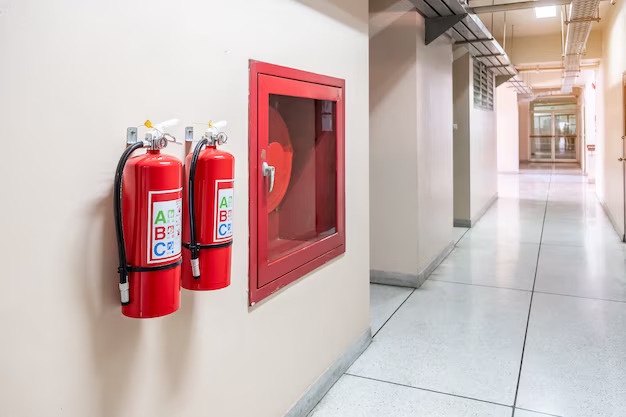In the realm of fire safety, few tools are as essential as the fire extinguisher. These seemingly simple devices pack a powerful punch, serving as the first line of defense against fire emergencies. Whether in your home, workplace, or public spaces, a well-maintained fire extinguisher near me is your most reliable ally in preventing small fires from escalating into devastating disasters. In this comprehensive guide, we will explore the significance of fire extinguishers as the best safety tools you can own. We'll delve into their role in protecting lives and property, the various types available, and how to effectively use and maintain them.
I. The Power of Fire Extinguishers
1.1. Immediate Fire Control
Fire extinguishers are designed for one primary purpose: to suppress fires. When a fire breaks out, having a properly maintained fire extinguisher on hand allows you to take immediate action, reducing the risk of the fire spreading and causing extensive damage.
1.2. Life-Saving Tools
In a fire emergency, every second counts. A functioning fire extinguisher can save lives by providing occupants with the means to suppress a fire or create a safe path for evacuation.
1.3. Legal Obligations
Fire safety regulations and codes often mandate the installation of fire extinguishers in specific buildings and environments. Compliance with these regulations is not only vital for safety but also to avoid legal repercussions, fines, and penalties.
II. The Diversity of Fire Extinguishers
2.1. Understanding Fire Classes
Fire extinguishers are categorized based on the types of fires they can effectively combat. These categories, known as fire classes, include Class A (ordinary combustibles), Class B (flammable liquids), Class C (electrical equipment), Class D (combustible metals), and Class K (kitchen fires).
2.2. Portable Fire Extinguishers
Portable fire extinguishers are the most common type and are suitable for residential and commercial use. They come in various sizes and are designed to be easily carried to the location of a fire.
2.3. Wheeled Fire Extinguishers
Wheeled fire extinguishers are larger and mounted on wheels, making them suitable for industrial or high-hazard environments. These heavy-duty units contain a significant amount of fire-suppressing agent and are designed for use by trained personnel.
III. Effective Use of Fire Extinguishers
3.1. Remember PASS
The PASS technique is a simple yet effective way to use a fire extinguisher:
- P: Pull the pin to unlock the extinguisher.
- A: Aim the nozzle at the base of the fire, not the flames.
- S: Squeeze the handle to release the extinguishing agent.
- S: Sweep the nozzle from side to side, covering the fire until it is out.
3.2. Safety First
Always prioritize safety when using a fire extinguisher. Ensure that you have a clear escape route, and do not attempt to extinguish a fire if it is spreading rapidly, the smoke is thick, or if the fire poses a threat to your safety.
3.3. Know Your Limits
Fire extinguishers have a limited supply of extinguishing agent, and attempting to extinguish a large fire with a small extinguisher can be dangerous. Use a fire extinguisher only when the fire is small and manageable.
IV. Maintaining Your Fire Extinguisher
4.1. Regular Inspections
Fire extinguishers should undergo routine inspections to ensure they are in working condition. This includes visual inspections to check for damage, tamper seals, pressure gauges, and accessibility.
4.2. Professional Servicing
Annual professional servicing by certified technicians is vital to maintain the fire extinguisher's internal components. Technicians check for wear, damage, or any signs of malfunction, and they can provide maintenance or recharging if needed.
4.3. Recharging and Hydrostatic Testing
Recharging may be necessary if the pressure gauge indicates that the extinguisher has been discharged or is losing pressure. Hydrostatic testing, which tests the strength of the extinguisher's shell, is typically required every few years to ensure safety.
V. Why a Fire Extinguisher Is Your Best Safety Tool
5.1. Immediate Response
Fire emergencies can happen without warning, and having a fire extinguisher readily available allows for swift and effective response, minimizing damage and risk.
5.2. Versatile Protection
Fire extinguishers can combat a range of fire types, making them versatile tools for various environments, including homes, offices, factories, and vehicles.
5.3. Legal Compliance
Compliance with fire safety regulations and codes is an essential aspect of owning and maintaining fire extinguishers. Meeting these standards is necessary for safety and legal protection.
Conclusion
A well-maintained fire extinguisher is not just a safety tool; it is the best safety tool you can own. Its ability to suppress fires, save lives, and protect property cannot be overstated. By understanding the significance of fire extinguishers, knowing how to use them effectively, and ensuring their regular maintenance and compliance with regulations, you actively contribute to a safer environment for yourself, your loved ones, and those who share your spaces. Remember, fire safety begins with you and the invaluable tool at your disposal: the fire extinguisher.


No comments yet